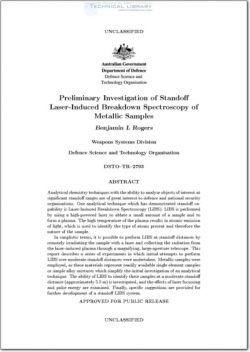DSTO-TR-2793

- Version
- 66 Downloads
- 1.23 MB File Size
- 1 File Count
- August 10, 2016 Create Date
- August 10, 2016 Last Updated
Preliminary Investigation of Standoff Laser Induced Breakdown Spectroscopy of Metallic Samples

Analytical chemistry techniques with the ability to analyse objects of interest at significant
standoff ranges are of great interest to defence and national security organisations. One
analytical technique which has demonstrated standoff capability is Laser Induced Break—
down Spectroscopy (LIBS). LIBS is performed by using a laser to ablate a small amount
of a sample and to form a plasma from this ablated material. The high temperature of the
plasma results in atomic emission of light. The wavelength of this light is characteristic
of the emitting atom, and can therefore be used to identify the type of atoms present and
therefore the nature of the sample.
In simplistic terms, it is possible to perform LIBS at standoff distances by remotely
irradiating the sample with a laser and collecting the radiation from the laser—induced
plasma. However, the introduction of standoff distance complicates the technique due
to laser focussing and diffraction, and laser—induced plasma radiation collection. It is
potentially possible to overcome these difficulties by introducing laser focussing elements,
a high—powered laser, and a magnifying telescope of large aperture for the collection of the
radiation.
Experiments were conducted to investigate the ability of LIBS to identify metallic
samples over moderate standoff distances (approximately 3.5 m). In order to simplify
the experiments, the investigation was limited to metallic samples, as these provide read—
ily available single element samples or simple alloy samples containing a low number of
elements.
A lens was used to focus the high—energy laser pulses onto the sample, while a 6”
aperture Newtonian telescope was used to collect the radiation from the laser—induced
plasma. Differentiation of a range of metallic samples was trivial under these experimental
conditions. Spectra obtained under these conditions clearly exhibit intense peaks which
are characteristic of the elements present in the sample.
Further experiments focussed on characterising the effects of varying the laser pulse
energy and removing the laser focussing lens. Both of these variations effectively vary
the power density of the laser pulses impinging upon the sample. As expected, reducing
the laser pulse energy or removing the laser focussing lens resulted in decreases in the
absolute intensity of spectral peaks, and a decrease in the quality and signal to noise ratio
of the spectra. This is believed to be due to the decrease in laser power density resulting in
reduced sample ablation and plasma formation, and reduced plasma temperature resulting
in lower emission intensity.
| File | Action |
|---|---|
| DSTO-TR-2793 Preliminary Investigation of Standoff Laser Induced Breakdown Spectroscopy of Metallic Samples.pdf | Download |

Comment On This Post